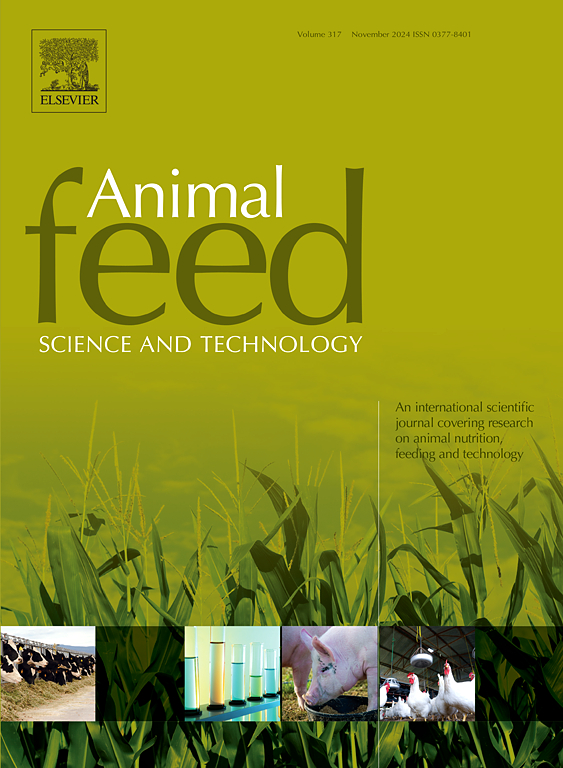角质胶副产物固态发酵对欧洲鲈鱼免疫状态和肠道菌群的影响
IF 2.7
2区 农林科学
Q1 AGRICULTURE, DAIRY & ANIMAL SCIENCE
引用次数: 0
摘要
前期研究发现,饲粮中添加10 %角质瘤副产物与葵花饼混合物(比例为1:1;替代玉米蛋白粉的Gmix降低了欧洲黑鲈幼鱼的饲料利用效率,而与伊曲霉发酵的Gmix可恢复饲料效率、氮和能量利用,达到与对照饲料相当的水平。本研究旨在通过评估其调节欧洲鲈鱼幼鱼肠道免疫和氧化状态以及微生物群的潜力,进一步评估这种未发酵或发酵的伊比利亚弧菌混合饲料。在生长试验结束时,各组间肠道抗氧化酶活性和脂质过氧化水平相似,但谷胱甘肽过氧化物酶活性明显高于对照组。总谷胱甘肽和还原性谷胱甘肽水平各组间相似,但发酵Gmix饲粮的氧化谷胱甘肽水平高于其他饲粮。血浆过氧化物酶和溶菌酶活性及远端肠免疫相关基因表达无显著差异。与对照饲粮相比,饲粮中添加未发酵和发酵的Gmix调节了肠道微生物群,特别是在食糜水平,观察到链球菌、出口杆菌和芽孢杆菌属增加,乳酸杆菌属减少。总体而言,在欧洲鲈鱼的日粮中添加未发酵或发酵的混合饲料似乎不会对肠道氧化或免疫状态产生不利影响,但会调节肠道微生物群。然而,需要进一步的研究来充分了解欧洲鲈鱼健康、肠道微生物群和Gmix(包括未发酵和发酵)之间的相互作用,包括长期生长试验、炎症损伤试验和下一代肠道微生物组测序分析。本文章由计算机程序翻译,如有差异,请以英文原文为准。
Effects of solid-state fermentation of Gelidium corneum by-product on immune status and gut microbiota in European seabass
It was previously observed that dietary inclusion of 10 % Gelidium corneum by-product and sunflower cake mixture (1:1 ratio; Gmix), replacing corn gluten meal, reduced feed utilization efficiency in European sea bass juveniles, while the same mixture fermented with Aspergillus ibericus restored feed efficiency as well as nitrogen and energy utilization, achieving levels comparable to the control diet. The present study aimed to further evaluate this unfermented or A. ibericus fermented Gmix by assessing its potential to modulate the intestinal immune and oxidative status, as well as the microbiota profile of European seabass juveniles. At the end of the growth trial, intestinal antioxidant enzyme activities and lipid peroxidation levels were similar among groups, except for glutathione peroxidase activity, which was observed to be higher in fish fed the fermented Gmix diet than in the control diet. Total and reduced glutathione levels were similar among groups, but oxidized glutathione was higher with the fermented Gmix diet than in the other diets. Plasma peroxidase and lysozyme activities and immune-related gene expression in the distal intestine did not show significant differences. Compared to the control diet, dietary inclusion of Gmix, both unfermented and fermented, modulated the intestinal microbiota, particularly at the digesta level, where an increase in Streptococcus, Exiguobacterium, and Bacillus genera, and a decrease in Lactobacillus sp., was observed. Overall, including either unfermented or fermented Gmix in the diet of European seabass did not appear to adversely affect intestinal oxidative or immune status but modulated intestinal microbiota. However, further research is required to fully understand the interactions between European seabass well-being, gut microbiota, and Gmix (both unfermented and fermented), including long-term growth trials, inflammatory insult trials, and next-generation sequencing for intestinal microbiome analysis.
求助全文
通过发布文献求助,成功后即可免费获取论文全文。
去求助
来源期刊

Animal Feed Science and Technology
农林科学-奶制品与动物科学
CiteScore
6.00
自引率
6.20%
发文量
266
审稿时长
3 months
期刊介绍:
Animal Feed Science and Technology is a unique journal publishing scientific papers of international interest focusing on animal feeds and their feeding.
Papers describing research on feed for ruminants and non-ruminants, including poultry, horses, companion animals and aquatic animals, are welcome.
The journal covers the following areas:
Nutritive value of feeds (e.g., assessment, improvement)
Methods of conserving and processing feeds that affect their nutritional value
Agronomic and climatic factors influencing the nutritive value of feeds
Utilization of feeds and the improvement of such
Metabolic, production, reproduction and health responses, as well as potential environmental impacts, of diet inputs and feed technologies (e.g., feeds, feed additives, feed components, mycotoxins)
Mathematical models relating directly to animal-feed interactions
Analytical and experimental methods for feed evaluation
Environmental impacts of feed technologies in animal production.
 求助内容:
求助内容: 应助结果提醒方式:
应助结果提醒方式:


